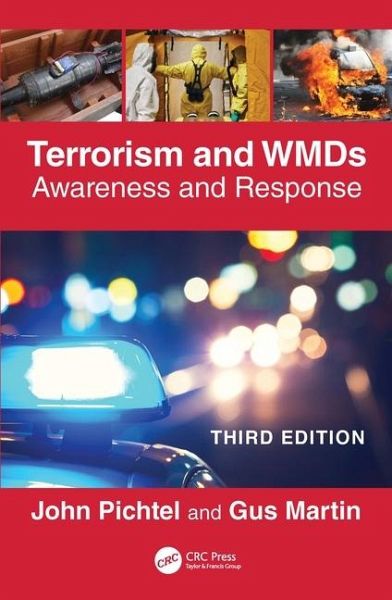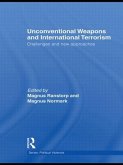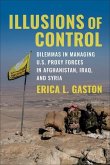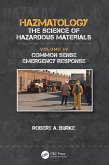- Gebundenes Buch
- Merkliste
- Auf die Merkliste
- Bewerten Bewerten
- Teilen
- Produkt teilen
- Produkterinnerung
- Produkterinnerung
Terrorism and WMDs: Awareness and Response, Third Edition is fully updated to include the latest technology and tactics surrounding the threats posed by terrorist groups-detailing plausible contexts in which chemical, biological, radiological, nuclear, and explosive (CBRNE) weapons could be used by such actors.
Andere Kunden interessierten sich auch für
![The Routledge Companion to Terrorism Studies The Routledge Companion to Terrorism Studies]() The Routledge Companion to Terrorism Studies320,99 €
The Routledge Companion to Terrorism Studies320,99 €![Unconventional Weapons and International Terrorism Unconventional Weapons and International Terrorism]() Unconventional Weapons and International Terrorism146,99 €
Unconventional Weapons and International Terrorism146,99 €![Illusions of Control Illusions of Control]() Erica L. GastonIllusions of Control134,99 €
Erica L. GastonIllusions of Control134,99 €![Interconnecting the Violences of Men Interconnecting the Violences of Men]() Interconnecting the Violences of Men202,99 €
Interconnecting the Violences of Men202,99 €![Common Sense Emergency Response Common Sense Emergency Response]() Robert A BurkeCommon Sense Emergency Response189,99 €
Robert A BurkeCommon Sense Emergency Response189,99 €![Police and Military Dogs Police and Military Dogs]() John EnsmingerPolice and Military Dogs192,99 €
John EnsmingerPolice and Military Dogs192,99 €![Inside the IRA Inside the IRA]() Andrew SandersInside the IRA170,99 €
Andrew SandersInside the IRA170,99 €-
-
-
Terrorism and WMDs: Awareness and Response, Third Edition is fully updated to include the latest technology and tactics surrounding the threats posed by terrorist groups-detailing plausible contexts in which chemical, biological, radiological, nuclear, and explosive (CBRNE) weapons could be used by such actors.
Hinweis: Dieser Artikel kann nur an eine deutsche Lieferadresse ausgeliefert werden.
Hinweis: Dieser Artikel kann nur an eine deutsche Lieferadresse ausgeliefert werden.
Produktdetails
- Produktdetails
- Verlag: Taylor & Francis Ltd
- 3. Auflage
- Seitenzahl: 444
- Erscheinungstermin: 24. April 2025
- Englisch
- Abmessung: 254mm x 178mm
- Gewicht: 453g
- ISBN-13: 9781032743370
- ISBN-10: 1032743379
- Artikelnr.: 72107776
- Herstellerkennzeichnung
- Libri GmbH
- Europaallee 1
- 36244 Bad Hersfeld
- gpsr@libri.de
- Verlag: Taylor & Francis Ltd
- 3. Auflage
- Seitenzahl: 444
- Erscheinungstermin: 24. April 2025
- Englisch
- Abmessung: 254mm x 178mm
- Gewicht: 453g
- ISBN-13: 9781032743370
- ISBN-10: 1032743379
- Artikelnr.: 72107776
- Herstellerkennzeichnung
- Libri GmbH
- Europaallee 1
- 36244 Bad Hersfeld
- gpsr@libri.de
John Pichtel is a professor of natural resources and environmental management at Ball State University in Muncie, Indiana, where he has been on the faculty since 1987. He earned his PhD in environmental science at Ohio State University, MS in soil chemistry/agronomy at Ohio State, and BS in natural resources management at Rutgers University. His primary research and professional activities have been in management of hazardous materials, remediation of contaminated sites, and environmental chemistry. Dr. Pichtel teaches courses in emergency response to hazmat incidents, management of solid and hazardous wastes, environmental site assessment, and site remediation. Dr. Pichtel is a Certified Hazardous Materials Manager. He holds memberships in the Institute of Hazardous Materials Managers, the International Association of Arson Investigators, and the Indiana Academy of Science. He was selected as a Fulbright Scholar in 1999 and again in 2005. Dr. Pichtel has received extensive training from the U.S. Department of Homeland Security in response to chemical, biological, radiological, and explosive hazards. He has written two books addressing waste management and cleanup of contaminated sites, and has authored or coauthored approximately 50 research articles. He has served as a consultant in hazardous waste management projects and has conducted environmental assessments and remediation research in the United States, the United Kingdom, Ireland, Finland, and Poland. Gus Martin is a professor and founding chair of the criminal justice administration department at California State University, Dominguez Hills, where he teaches courses on terrorism and extremism, criminal law, and the criminal justice system. He has served as a founding director of the School of Public Service and Justice. He also served as Associate Vice President for Human Resources Management, Acting Associate Dean of the College of Business Administration and Public Policy, Associate Vice President for Faculty Affairs, and Chair of the Department of Public Administration. He began his academic career as a member of the faculty of the Graduate School of Public and International Affairs, University of Pittsburgh, where he was an administration of justice professor. His current research and professional interests are terrorism and extremism, homeland security, and the administration of justice. Dr. Martin is the author of several books on the subjects of terrorism and homeland security. Prior to joining academia, Dr. Martin served as Managing Attorney for the Fair Housing Partnership of Greater Pittsburgh. He was also Special Counsel to the Attorney General of the U.S. Virgin Islands on the island of St. Thomas. Prior to serving as Special Counsel, he was a "floor" Legislative Assistant to Congressman Charles B. Rangel of New York. Dr. Martin received his AB degree from Harvard College, JD from Duquesne University Thomas R. Kline School of Law, and PhD from the Graduate School of Public and International Affairs at the University of Pittsburgh.
Introduction
Part I: Introduction to Weapons of Mass Destruction and Terrorism
1. Weapons of Mass Destruction and the Terrorist Threat
2. Terrorism: History and Typologies
3. Terrorism: The Modern Environment
Part II: The Weaponization of CBRNE
4. Chemical Agents
5. Toxic Industrial Chemicals
6. Biological Agents
7. Nuclear and Radiological Hazards
8. Explosives Hazards
Part III: Deploying CBRNE and New WMD Technology
9. Delivery Systems for Weapons of Mass Destruction
10. Directed-Energy Weapons
Part IV: Responding to CBRNE Incidents
11. National Incident Management System and the Incident Command System
12. Personal Protective Equipment for Emergency Response, Decontamination,
and Remediation
Appendix A: Glossary
Appendix B: Acronyms
Appendix C: Selected Chemical and Physical Properties of Chemical Agents
Appendix D: Annotated List of Resources for Further Research
Part I: Introduction to Weapons of Mass Destruction and Terrorism
1. Weapons of Mass Destruction and the Terrorist Threat
2. Terrorism: History and Typologies
3. Terrorism: The Modern Environment
Part II: The Weaponization of CBRNE
4. Chemical Agents
5. Toxic Industrial Chemicals
6. Biological Agents
7. Nuclear and Radiological Hazards
8. Explosives Hazards
Part III: Deploying CBRNE and New WMD Technology
9. Delivery Systems for Weapons of Mass Destruction
10. Directed-Energy Weapons
Part IV: Responding to CBRNE Incidents
11. National Incident Management System and the Incident Command System
12. Personal Protective Equipment for Emergency Response, Decontamination,
and Remediation
Appendix A: Glossary
Appendix B: Acronyms
Appendix C: Selected Chemical and Physical Properties of Chemical Agents
Appendix D: Annotated List of Resources for Further Research
Introduction
Part I: Introduction to Weapons of Mass Destruction and Terrorism
1. Weapons of Mass Destruction and the Terrorist Threat
2. Terrorism: History and Typologies
3. Terrorism: The Modern Environment
Part II: The Weaponization of CBRNE
4. Chemical Agents
5. Toxic Industrial Chemicals
6. Biological Agents
7. Nuclear and Radiological Hazards
8. Explosives Hazards
Part III: Deploying CBRNE and New WMD Technology
9. Delivery Systems for Weapons of Mass Destruction
10. Directed-Energy Weapons
Part IV: Responding to CBRNE Incidents
11. National Incident Management System and the Incident Command System
12. Personal Protective Equipment for Emergency Response, Decontamination,
and Remediation
Appendix A: Glossary
Appendix B: Acronyms
Appendix C: Selected Chemical and Physical Properties of Chemical Agents
Appendix D: Annotated List of Resources for Further Research
Part I: Introduction to Weapons of Mass Destruction and Terrorism
1. Weapons of Mass Destruction and the Terrorist Threat
2. Terrorism: History and Typologies
3. Terrorism: The Modern Environment
Part II: The Weaponization of CBRNE
4. Chemical Agents
5. Toxic Industrial Chemicals
6. Biological Agents
7. Nuclear and Radiological Hazards
8. Explosives Hazards
Part III: Deploying CBRNE and New WMD Technology
9. Delivery Systems for Weapons of Mass Destruction
10. Directed-Energy Weapons
Part IV: Responding to CBRNE Incidents
11. National Incident Management System and the Incident Command System
12. Personal Protective Equipment for Emergency Response, Decontamination,
and Remediation
Appendix A: Glossary
Appendix B: Acronyms
Appendix C: Selected Chemical and Physical Properties of Chemical Agents
Appendix D: Annotated List of Resources for Further Research








